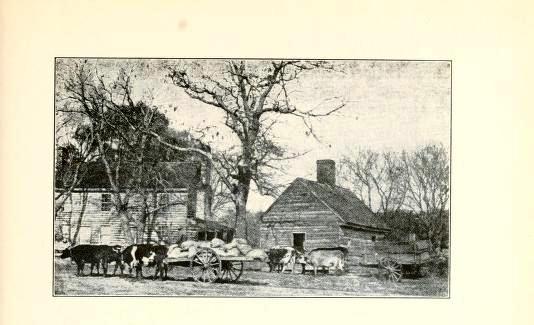The History of Caroline County, Maryland, From Its Beginning
The Plantation
HOME OF BETSY BAYNARD AS A TYPE OF EASTERN SHORE SLAVE HOLDER
Looking backward to the days when forests stretched for miles over an
acreage now covered by fertile farms, we see about five miles N.E. of
Greensboro, some distance from the Eastern bank of the Choptank River, a
small clearing appear. Soon arose a small unpretentious building
typical of its day. Tall pines overshadowed it. At dawn the
song of the woodland bird awakened the sleeper, while during the hush of
eventide the call of prowling wild animals sent a thrill of fear through
the listener. Such in the 17th century was the beginning of the Baynard plantation—the
largest in the Greensboro section—extending over an area of more than
six hundred acres.
Time was in the early slave days when
tobacco flourished there, and Negroes, singing their weird melancholy
songs “toted” the tobacco to their storeroom. From thence it was
carried over the woodland road and delivered at the warehouse of William
Hughlett for even in the 17 hundreds the dense green of
Maryland pines had given way to the paler green of cultivated fields.
First the Baynards planted tobacco, but
later cereals formed the base of income; while in the last days of the
plantation, to these were added the returns from tanbark and railroad
ties.
In 1812 “Old Massa
Baynard” died and Mistress Betty,
then sixteen years old, became— under her mother—the Autocrat of the
Plantation.
The home with its rambling Negro
quarters had been enlarged and, while never ostentatious, held old
china, colonial furniture, a grandfather’s clock and other antiques such
as delight the eye.
There after her mother’s death Betsy Baynard lived
alone save for her house servant, Myna, and two
powerful dogs who stood guard day and night. Completing this
plantation community were her slaves who fill their huts to overflowing,
at times numbering more than two hundred.
Although not given to slave dealing,
at the time of enlarging her house to obtain the needed money Betsy sold
a servant “South into Georgia.”
“They say” the cartwhip was daily
used as a ruling power among her colored people but the blows must have
fallen lightly for many of her slaves remained contentedly on her
plantation until old and infirm, and when she died ten years after the
Emancipation some half dozen of her slaves were yet with her.
An amusing anecdote of the Baynard slaves
relates that a young Negro, returning from a dance, in the cold, gray
dawn went to the well for a drink of water. As his eye followed
the bucket on its descent he saw something white. True to race
superstition he believed it a spirit and ran to tell Miss
Betsy of “De hand in de well.” She returned with
him and found a sheep had fallen in and all but drowned.
A tragedy of the plantation was the
death of Miss Mary Reid, a cousin of Miss
Betsy’s, who at times made her home there. A slave girl, on
being reprimanded for some delinquency, took offense and attempted
revenge on Betsy by way of Paris green.
The poison miscarried, resulting in Miss Reid’s death
almost immediately.
As a memorial to the Baynard generosity
stands Irving Chapel. While the name is that of the first
minister, the plat of land on which Irving Chapel stands was donated
from the Baynard plantation, and the
lumber for the building was added on condition that the church members
cut it from the forest. Miss Baynard also
gave a sum of money, large in those days and sufficient for church
erection.
Betsy Baynard died without
direct lineal descendant. The land was sold in small sections, and
is owned principally by Rosanna Richards, G. W.
Richards, A. K. Brown and J. A.
Meredith. All that remains to recall the story of other days
is a portion of the old home which is yet in use by J.
A. Meredith, and a small family burying ground with three markers—
Written from material collected by Paul Meredith.William Baynard born 1769, died 1812.
Litia Baynard born 1773, died 1843.
Elizabeth Baynard born 1796, died 1873.
